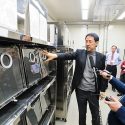New technique can create flu viruses
A research team has perfected a method for creating designer influenza viruses, which can be tailor-made to solve mysteries about how flu strains mutate, spread and cause illness.
The development may also lead to more efficient influenza vaccines and safer gene therapies, says Yoshihiro Kawaoka, a virologist and author of the report in the Aug. 3 Proceedings of the National Academy of Sciences (PNAS).
“This technology should help us gain a greater biological understanding of influenza and improve our methods of disease control,” says Kawaoka.
Scientists have tried for years to create influenza viruses in the laboratory, but the process is made difficult by of the complexity of the virus, Kawaoka says. The influenza genome has eight different segments of RNA, compared to only one in viruses such as rabies.
To accomplish the feat, the researchers used a basic ingredient in biotechnology called plasmids, which are independent segments of DNA capable of replicating on their own. Plasmids are commonly used in science to transport genetic material from one cell to another.
Kawaoka and his School of Veterinary Medicine research group introduced eight plasmids – one for each segment of flu RNA — into a common line of cells used for research. They also introduced nine other plasmids into the cells that serve as building blocks for the proteins needed to make a complete influenza virus.
Although Kawaoka says they are not entirely sure why the system works so well, it is producing viruses in about one in every 1,000 cells. It’s a 1,000-fold improvement over current methods, which only produce altered viruses but not entirely new ones.
This technology is exciting, Kawaoka says, because it allows scientists to precisely manipulate influenza viruses by flipping genetic switches and producing mutations, which can expose the flu’s complex machinery.
“With this technology, we can introduce mutations any way we want,” he says. “We can control the virulence by mutating here, there, anywhere. That could help us generate a live vaccine that is also stable.”
Kawaoka says current inactivated flu vaccines are good, but can be improved. Live vaccines could be advantageous because they induce both cellular and antibody immune responses. They also produce immunity where it needs to be, such as the nasal cavity and respiratory tract.
There may be even broader applications in gene therapy in areas such as cancer treatment, he says. In fighting cancer, doctors want to introduce genes that effectively kill cancer cells but will not replicate in the body and damage healthy tissue. The influenza virus may be an ideal vector, Kawaoka says, because it does not get integrated into the human genome.
Influenza remains a major public health menace, killing an average of 20,000 people each year and infecting up to 40 million people in the U.S. alone. Influenza-related health costs top $4.6 billion per year. But basic mechanics of the virus, such as what triggers dangerous shifts in flu strains, are poorly understood.
Kawaoka says this technology will be valuable from a basic science perspective. They can use cloned viruses to study influenza viral growth, pathogenesis, and what allows some viruses to transmit across species.
For example, avian flu viruses almost never transfer to humans, but when they do they can be particularly deadly, such as the 1997 Hong Kong virus. “Now we can introduce mutations in the avian influenza virus and understand for the first time what makes these viruses grow in humans,” he says.
A dozen researchers worked on the project, including post-doctoral researcher Gabrielle Neumann and graduate student Tokiko Watanabe. The research was supported by the National Institute of Allergy and Infectious Diseases Public Health Service, a division of the National Institutes of Health.


